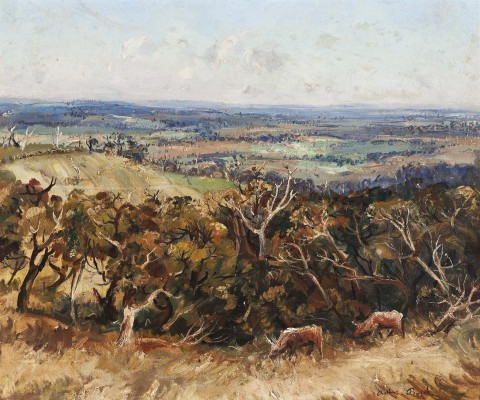BERWICK LANDSCAPE, c.1948
ARTHUR BOYD
oil on canvas on composition board
51.0 x 61.5 cm
signed lower right: Arthur Boyd
Mr and Mrs Hal Hattam, Melbourne
Christie’s, Sydney, 5 October 1971, lot 259
D.R. Sheumack Collection, Sydney
Sotheby’s, Melbourne, 25 August 1997, lot 186
Private collection, Sydney
The D.R. Sheumack Collection of Australian Paintings, S. H. Ervin Museum and Art Gallery, Sydney, 17 May – 12 June 1983, cat. 9 (as ‘Berwick Landscape II’)
Christie, R. and Miller, J. (eds), The D. R. Sheumack. Collection. Eighty Years of Australian Painting, Sotheby's Australia Pty Ltd, Sydney, 1988, cat. 108 (illus. as ‘Berwick Landscape 2’)
Landscape near Berwick, 1948, oil on canvas, 50.9 x 73.2 cm, in the collection of the National Gallery of Australia, Canberra
Spanning his entire creative oeuvre, Arthur Boyd’s landscapes provide some of the most perceptive insights into the Australian countryside and its many idiosyncrasies. Following his discharge from the army in 1944, Boyd delved into a series of works that were steeped with allegory and symbolism, addressing his personal reaction to the tragedies of World War Two. However, as the war receded further into the past, Boyd’s paintings, and particularly his landscapes, became gradually more relaxed, reflecting an increasingly peaceful disposition.
In 1948, Boyd’s uncle, novelist Martin Boyd, invited him to paint a mural for the dining room at ‘The Grange’–the Boyd family home in Harkaway. This invitation (and the artist’s first major commission) enabled the artist to extricate himself from the busy day-to-day operation of the Murrumbeena pottery he managed with his brother-in-law and fellow artist, John Perceval, and devote himself entirely to painting. Boyd was, while painting these allegorical Harkaway frescoes, enchanted by his surrounds and inspired to paint some of his most beautiful landscapes. For Boyd, it was a period of high achievement, as he applied the study of the techniques of the Old Masters, most notably Pieter Bruegel the Elder. Originally inspired by Bruegel’s expression of historical subjects, Boyd’s pure landscapes were increasingly influenced by the Flemish painter in their typically high viewpoints and ’the tuning in of the intimacy of the closely seen – the slope and mould of the fat brown earth, the way a path rises and filters into a copse … with the fulness of a complete world of wide horizons, high sky and distant hills’.1
Berwick, situated some thirty kilometres east of Melbourne in the foothills of the Dandenong ranges, was a region adorned with a bucolic ambiance. Yet, as Franz Philipp describes when writing of Boyd’s Berwick period, the area maintained an equally primordial quality which captivated the artist:
’With its undulating hills, its spinneys of gums, with its cultivated fields, grassy paddocks, small dams and iron windmills it is finite, formed, half wild, half pastoral, smaller and more densely inhabited than Australian landscape generally is. It offers both intimacy and width of horizon. Arthur Boyd – I have already called him a born landscapist – responded to it with love and joy’.2
In Berwick Landscape, c.1948, the fertile land is cultivated, yet the foreground is thick with brambles and untamed trees. From the spindly growth emerge two grazing cows, a reminder of the human habitation in the region. The eye is drawn to this pocket of agrarian activity, yet this intimacy does not lessen the impact of the overall breadth and scale of Boyd’s vision. Much like Bruegel’s Return of the Herd, 1565, the scene is pastoral, yet it preserves traces of the land’s primeval character, ultimately depicting a breezy panorama in which man and nature coexist peacefully.
Once owned by Boyd’s fellow artist and friend, Hal Hattam, Berwick Landscape, c.1948 is a splendid example of Boyd’s ’poetry of wonder’3 and his immense ability to interpret the rural Australian environment.
1. Philipp, F., Arthur Boyd, Thames and Hudson, London, 1967, p. 60
2. ibid., p. 59 – 60
3. ibid., p. 64
MELISSA HELLARD
